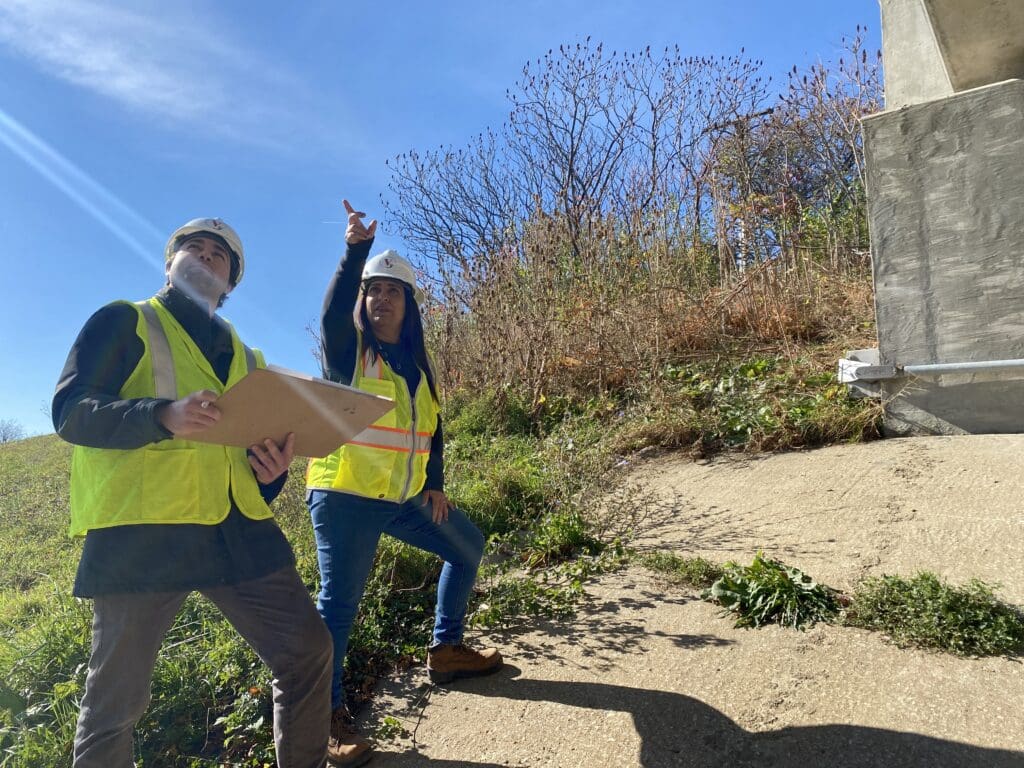Our structural engineering clients often ask us, “How can I improve the safety, longevity, and functionality of my bridge inventory?” We spoke to V3’s VP of Structural Engineering Zaida Morillo to learn why following a preventative bridge maintenance program is not only cost effective but vital for public safety.
What is a bridge maintenance program?
Most modern bridges are designed to last 75 years, but just like with maintaining a car or home, regular care goes a long way in ensuring functionality for years to come. Bridges that receive preventative maintenance can enjoy even longer lifespans by addressing small issues before they grow into larger, more expensive problems.
Bridge maintenance programs oversee bridge lifecycles to address safety issues and plan for necessary rehabilitation. Developing a proactive approach to maintenance, repairs, and reconstruction is vital for long term bridge safety.
Preventative bridge maintenance includes:
Inspections
Many bridges require inspections every two years. Structural engineers inspect every bridge component from the deck to the beams looking for cracks, corrosion, or deterioration. While official inspections should take place every other year, encouraging staff to be an extra set of eyes and ears looking when they are working in a bridge’s vicinity helps catch minor concerns before they lead to a major problem.
- Are the drainage scuppers, floor drains, or other drainage systems clogged with debris?
- Has a new crack or spall appeared in the bridge deck or a pier?
- Has debris collected around a bridge pier or been found in the stream?
- Are the tops of the abutment or pier caps wet after a rain or have a lot of debris collected?
- Are lights on during the day when they should not be on or are lights not working at night?
- Is there a bump on the bridge or approach that you didn’t notice before?
- Are the railings damaged?
- Is the scour around a culvert opening?
- Are trees and heavy vegetation growing close behind wingwalls?
Minor repairs and routine maintenance
Joint replacement is one of the most common bridge repairs, as joints experience significant wear and tear. The combination of water and salt is poison to bridges and needs to be controlled. Ensuring joints are properly sealed prolongs their performance and minimizes the likelihood of future major repairs. Creating a budget line item for this work ensures funds are readily available and identified needs can be addressed quickly.
- Watertight joints are critical to prevent deterioration of the beam ends and the concrete substructure below the joint.
- Routine sealing of concrete surfaces prevents salt penetration.
- Asphalt is not an appropriate long-term solution for a spall in a deck. While asphalt patching is a short-term solution to get rid of the bump, the problem needs to be addressed with appropriate concrete repairs as soon as possible.
Cleaning
Bridges are exposed to the elements as well as residue from cars, trucks, and travelers. Regular pressure washing helps maintain the integrity of built materials, especially for bridges located in harsh climate conditions or over water where algae or salt from snow plowing can create issues.
- Clean scuppers and floor drains
- Wash salt off beam ends and bearing seats
Stay safe with bridge inspections

Inspections are the most important component of bridge maintenance. Every bridge has its own load rating determined by the National Bridge Inspection Standards (NBIS). Bridges are rated on a scale of how much weight they can support, but over time that rating could change due to weakened supports or deteriorated members. Bridge inspections and load ratings evaluate how much capacity is left and what needs to be done to maintain the initial rating of the structure.
Using AASHTOWare BrR for analytical load ratings combined with engineering judgment provides a comprehensive understanding of a bridge’s live load capacity. This combination is crucial for maintaining public safety and ensuring that bridges can handle the expected traffic loads without compromising structural integrity. Load posting a bridge may be necessary for setting weight limits to ensure the bridge’s safety and longevity.
Smaller bridges less than 20 feet may not have to be reported to governing agencies such as IDOT, but implementing a Small Bridge Inspection Program is highly recommended, as these structures still need routine inspections and preventative maintenance. Caring for bridges of all sizes is essential for public safety and helps minimize expensive repairs in the long run.
Working with a bridge program manager helps streamline the inspection process. Structural engineers not only conduct the inspections but create detailed reports, timelines, and cost analyses to plan for the future. These detailed professionals ensure bridges stay up to code and make expert recommendations for safety and functionality.
Use high-performance bridge materials
Once it is time for bridge repairs or reconstruction, using high-quality building materials is a smart investment for bridge longevity. Innovations in technology and high-performing construction have led to enhanced resources that lead to stronger, longer-lasting structures that are protected from the elements.
Examples of high-performance bridge materials include:
- High-performance concrete
- Carbon fiber reinforced polymers
- High-strength steel alloys
- Weathering, galvanized, or metallized steel
- Stainless steel reinforcement
While some of these materials may come with a higher initial cost, longer-lasting elements create less maintenance and issues in the future, making them more cost effective in the long run. In addition, fewer repairs mean less traffic disruption and labor costs, which can make a big difference in maintenance budgets.
Maintain your bridges with V3’s Structural Engineering experts
Our structural engineering team sits side-by-side with civil engineers, hydraulic engineers, environmental specialists, and construction experts, giving us a holistic view of today’s infrastructure challenges. Our multidisciplinary approach allows for context-sensitive design that represents both the best and most cost-effective solutions for your project. Connect with us to learn more.

